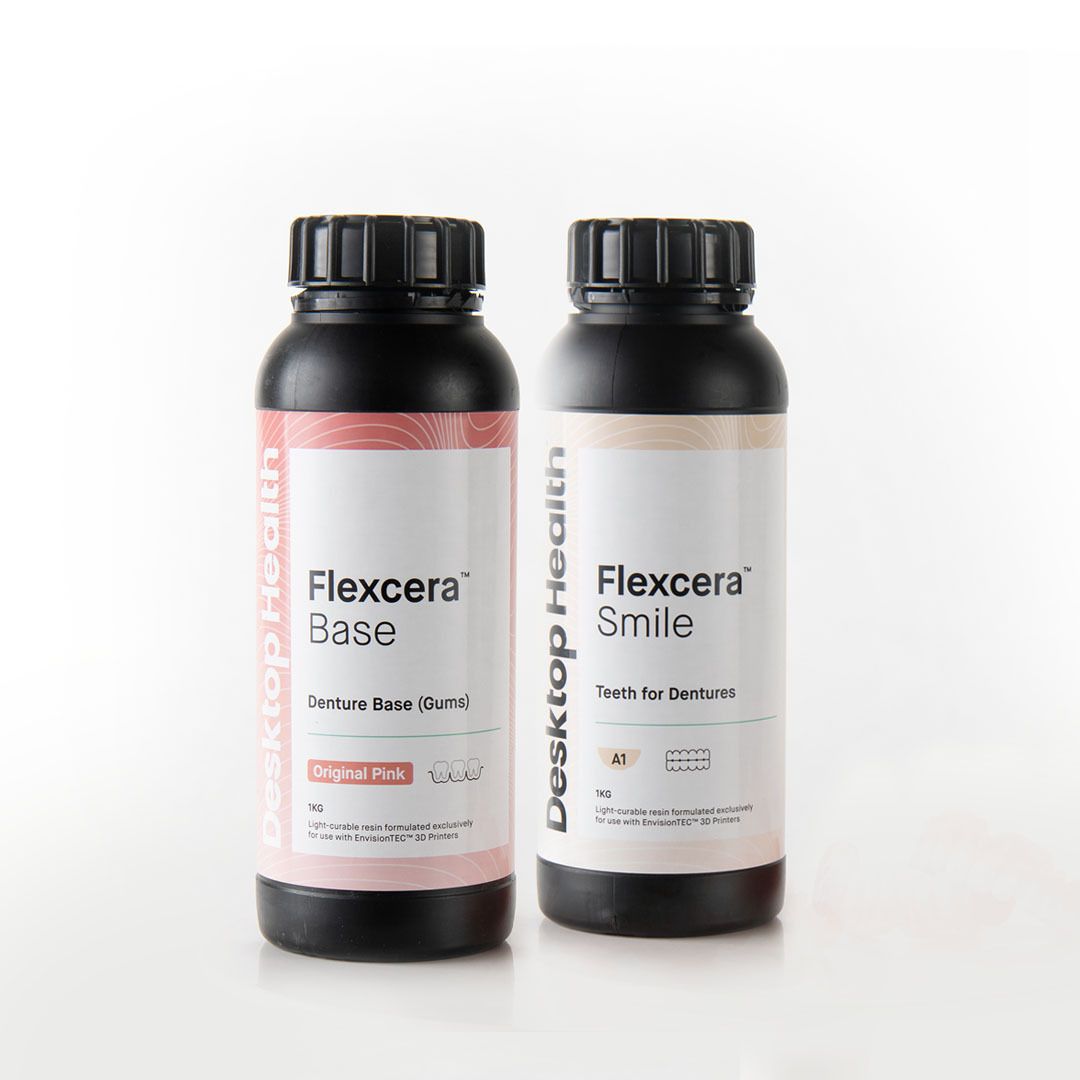Flexcera 3D Resin
- Available as Flexcera Smile and Flexcera Base
- Its long-chain chemistry provides ceramiclike strength
- Said to be about 3 times more resistant to fracture and 2 times more resistant to moisture
- Flexcera Base is a light-curable resin for the fabrication of high-impact and removable denture bases.
- Flexcera Smile is a light-curable resin for the fabrication of high-impact artificial teeth with variable translucency for dentures.
- Formulated exclusively for use with EnvisionTEC 3D printers
Desktop Health
866-344-3578 | desktophealth.com
The digital denture concept is not new and was introduced to the dental industry in 2011. Early on, digital systems required convoluted workflows with what some would say were lackluster esthetics and strength. Over the years different manufacturers developed and released their versions into the market with not much fanfare. The development of technologies coupled with materials has moved at an exponential pace in recent years, with manufacturers seeing a need in the market for simple digital workflows coupled with high-strength, high-esthetic materials.
More recently, advancements in printing technology and materials have led the way forward on a new path and breathed life into the digital denture market, making them more of a reality today than ever before. With these advancements came simple, easy-to-use workflows for both clinicians and technicians.
While this gave the industry capability to realize the fullest extent of the technology, there was a drawback when it came to the teeth themselves. Although new additions to the market have proven esthetic and strong, there have been some downsides, such as initial startup costs and the use of proprietary carded teeth.
In 2021, Desktop Health released Flexcera Base and Flexcera Smile (Figure 1). These printable materials were developed and validated for Desktop Health’s line of EnvisionTEC printers (Figures 2a-2b). This provided another great entry into the digital denture market. This release meets the industry demand for strength and esthetics with leading performance, while maintaining a cost-effective option for entry into the system.
This cost-effective entry has given more laboratories the ability to offer digital dentures. There are many benefits to a printable tooth solution, such as the ability to choose from a multitude of libraries, as well as scalability to meet production demands. By providing a printable tooth solution, this has given technicians the ability to customize the occlusion with ease. A fully customizable denture gives way to the ability to meet clinicians and demands in a rapidly growing area of the industry. These 2 materials were developed to work together in a system to be able to achieve the desired goal of any case.
Carded teeth in some cases can hinder the designer, as the library cannot be adjusted (Figures 3-4). Therefore, in many instances difficulties arise in the successful designing of a case due to the inability of the designer to adjust and customize the occlusion. For example, when designing a duplicate denture from an existing denture, it becomes more difficult to exactly match existing denture teeth within a preset library.
Flexcera has shown to be 3 times more resistant to fracture, with total work fracture numbers exceeding 3600J/m2. This ceramic-like material also exhibits a water absorption rate of 1.96%. This very low rate provides great resistance to moisture which aids in the ability to prevent staining or discoloration from liquids. Flexcera Smile produces a natural esthetic and exhibits ceramic-like translucency. When manufacturing teeth with Flexcera Smile, technicians gain the added benefit of being designed as a mono-track 1-piece design that is more resistant to tooth pop. The 1-piece design can be placed and luted into the base in a very efficient manner.
Flexcera Base was introduced in 5 shades—light pink, medium pink, original pink, dark pink, and dark meharry (Figure 5). Flexera Smile is available in these popular shades: Bleach, A1, A2, A3, A3.5, and B1 (Figure 6). The multitude of base and tooth shades gives the laboratory the ability to produce dentures in the most popular and requested shade combinations. Also, Flexcera Base does have the ability to accept conventional carded teeth if desired. Postprocessing of the materials follows typical laboratory procedures associated with 3D printing (Figure 7).
Although not indicated for use, the material can also be used to fabricate additional products within the dental laboratory such as high-strength esthetic hybrid provisionals.
These provisionals aid in the predictability of large complex cases and provide much value to the restorative team. The ability to print these provisionals efficiently is a great benefit to the dental laboratory today (Figure 8).
Laboratories that adopt this system will also gain capabilities that go with digital dentures that offer great advantages as compared to a traditionally processed denture, including the ability to archive the design data. This may be one of the greatest advantages to a dental laboratory and clinician. Having the ability to remanufacture a denture proves to be an incredible time save in an instance of a lost or broken denture.
As we move forward, we will continue to see product offerings and innovation from companies such as Desktop Health. These innovations will give the modern dental laboratory a competitive edge in the market and aid the laboratory in meeting production demands when dealing with a shrinking workforce.

